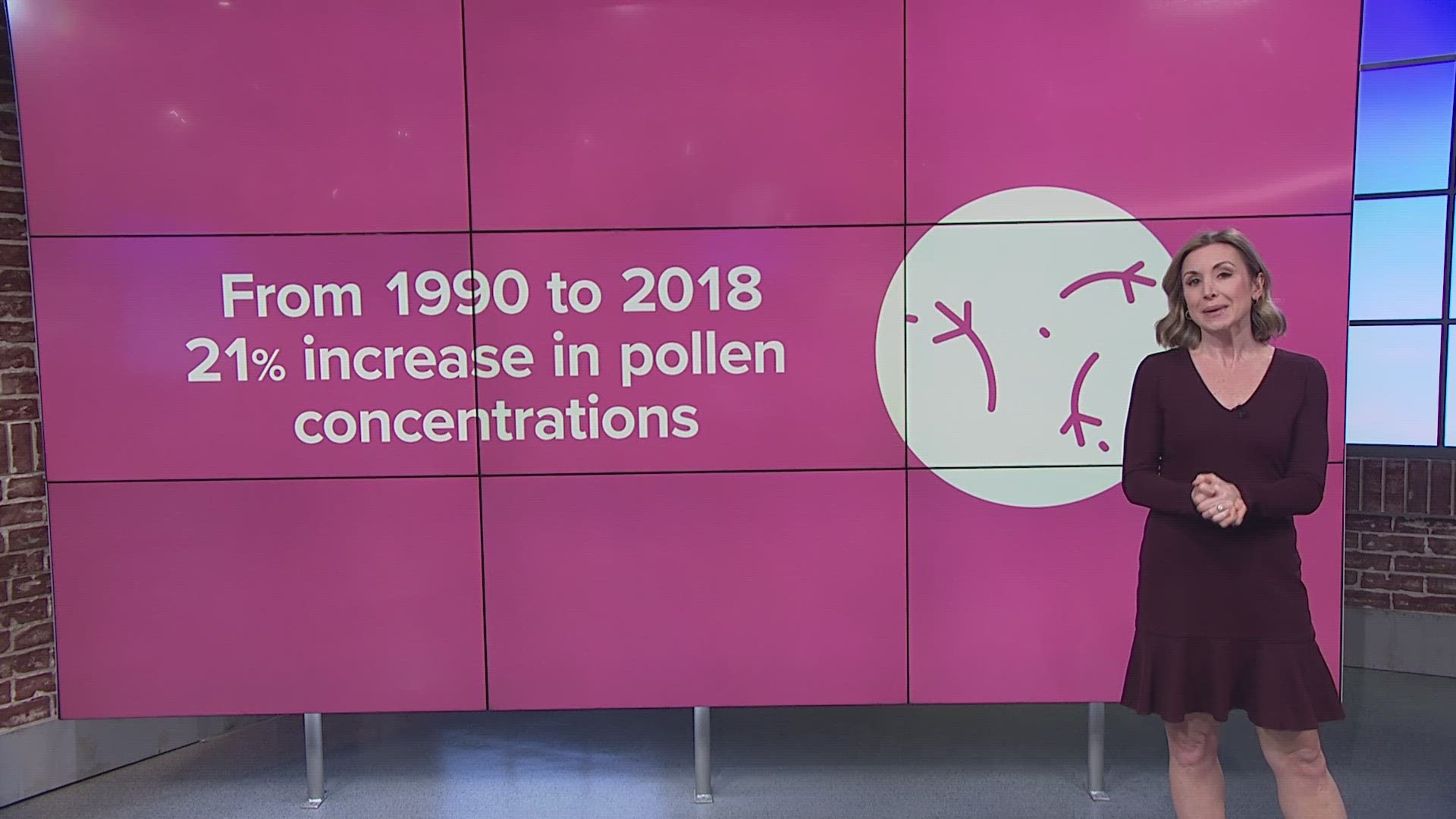WASHINGTON — When it comes to how prevalent allergy problems will be, it really comes down to warming global temperatures and the impact on the growing season. Longer periods of freeze-free days mean that trees and plants have more time to flower and release that agitating pollen.
A recent study revealed that the pollen season in North America has become longer by an average of 20 days and more intense with a 21% increase in pollen concentrations from 1990 to 2018. People are definitely feeling the effects.
"I never had them when I was younger and then like two years ago I started getting watery eyes, and like a little stuffy nose, nothing crazy," India Shore said.
These are symptoms Shore said she only started to experience in the last several years.
"I feel like last year specifically was the first year I was like, this feels a lot worse," Claire Altendahl said. "A lot of drippy nose all that fun stuff it was awful."
Symptoms for people with seasonal allergies aren't only getting worse, but they're starting earlier.
"One of the trends that I'm seeing is patients saying that their allergy symptoms are starting earlier and earlier, and I hear this every year," said Dr. Neelu Tummala, an ear, nose and throat physician at George Washington University School of Medicine and co-director of the Climate Health Institute.
Dr. Tummala said increased carbon dioxide in the atmosphere is thought to be one of the main contributing factors to higher-than-average pollen levels.
"When you have increased CO2 and have higher levels of pollen, of course, you're going to have worsening pollen allergy symptoms because there's more pollen to deal with," Tummala said.
Another thing that studies have shown is that the pollen itself is more allergenic, meaning that it produces more symptoms.
"Pollen now tends to produce more symptoms of sneezing, nasal congestion, itchy watery eyes, post nasal drainage than pollen previously," Tummala confirmed.
If you're prone to seasonal allergies, you may want to start taking steps now to alleviate symptoms. Oral allergy medications should be taken on days when symptoms are bothersome, but effective nasal sprays need more lead-up time.
"We usually like to start these sprays for patients about two weeks before the onset of pollen allergy season," Tummala said. "So now that tree pollen levels are already high if you have not started and these are medications that you normally take to manage your pollen allergy symptoms, I do recommend going ahead and starting them or touching base with your healthcare provider to make sure that they're the right thing to move forward."
And there are simple actions you can take this time of the year to mitigate the impacts of pollen.
First and foremost, check the pollen count. You can always find the latest pollen measurements on our WUSA9's app or website. On days when pollen is high, it might be best to just stay inside, especially if it's windy and pollen will be blowing around. The best time to get outside and avoid allergens is after a good rain. Keep your windows closed when you're driving and at home. Avoid mowing the lawn, pulling weeds and other outdoor activities that stir up pollen. Remove clothes you've worn outside and shower to rinse pollen from your skin and hair.
Don't forget about your pets! Give them a bath to keep them clean as well.
Scientists are also seeing pollen appearing in new geographic regions. That's related to changes in temperature and precipitation patterns. When you have trees able to grow in new regions, then you're introducing pollen to new regions, and people who are otherwise not sensitized that pollen may now become sensitized and develop allergy symptoms.
MORE WAYS TO GET WUSA9
DOWNLOAD THE WUSA9 APP
Apple App Store: WUSA9 News on Apple
Google Play Store: WUSA9 News on Android
HOW TO ADD THE FREE WUSA9+ APP TO YOUR STREAMING DEVICE
ROKU: add the channel from the ROKU store or by searching for WUSA9.
For both Apple TV and Fire TV, search for "WUSA9" to find the free app to add to your account. Another option for Fire TV is to have the app delivered directly to your Fire TV through Amazon.
SIGN UP TO RECEIVE WUSA9 NEWSLETTER
Subscribe to our daily WUSA9 Newsletter for top stories from WUSA9 curated daily just for you. Get content and information right now for can’t-miss stories, Commanders content, weather, and more delivered right to your inbox.

